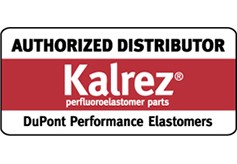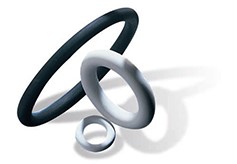 Kalrez® parts made from compounds 6221 and 6230 provide superior chemical resistance and low contamination from extractables in pharmaceutical and food handling applications where FDA compliance is required. Compounds 6221 and 6230 are especially suited for Water For Injection (WFI) systems, Steam-in-Place (SIP) cleaning and other critical systems,
Kalrez® parts made from compounds 6221 and 6230 provide superior chemical resistance and low contamination from extractables in pharmaceutical and food handling applications where FDA compliance is required. Compounds 6221 and 6230 are especially suited for Water For Injection (WFI) systems, Steam-in-Place (SIP) cleaning and other critical systems,
Unlike other elastomeric seals made with FDA compliant elastomers, Kalrez perfluoroelastomer parts are thermally stable up to 260°C (500°F), permitting use in applications such as Stage II Sterilization processes, where other elastomers lose their sealing capabilities.
 In aggressive pharmaceutical and semiconductor processing environments, seal failure from excess swelling, embrittlement or decomposition can cause unscheduled downtime or product contamination. Elastomeric materials that come in contact with highly pure and aggressive water (e.g., WFI) must be chosen with care in order to prolong seal life.
In aggressive pharmaceutical and semiconductor processing environments, seal failure from excess swelling, embrittlement or decomposition can cause unscheduled downtime or product contamination. Elastomeric materials that come in contact with highly pure and aggressive water (e.g., WFI) must be chosen with care in order to prolong seal life.
The perfluoroelastomer compounds used in Kalrez parts have been shown to have extremely low to non-detectable extractable levels in aggressive water systems. Because the perfluoroelastomer polymer in Kalrez® parts is fully saturated, it is also well suited for Ozonated Deionized Water service. Kalrez perfluoroelastomer parts also exhibit very low swell and loss of mechanical properties after repeated steam cycling.
General Chemical Resistance
The overall chemical resistance of EPDMs, silicone elastomers and fluoroelastomers (FKM) is limited by their respective polymer structures. Kalrez perfluoroelastomer parts, on the other hand, offer the same universal chemical resistance as PTFE, but unlike PTFE, they have elastomeric properties, which help them maintain their sealing capabilities. Table 1 lists the chemical compatibility of Kalrez perfluoroelastomer parts and other elastomers used as sealing materials in the pharmaceutical and food handling industries.
| |||||||||||||||||||||||||||||||||||||||||||||||||||||||||||||||||||||||||||||||||||||||||||||||||||||||||
| ||||||||||||||||||||||||||||||
| The information set forth herein is furnished free of charge and is based on technical data that DuPont Dow Elastomers believes to be reliable. It is intended for use by persons having technical skill, at their own discretion and risk. The handling precaution information contained herein is given with the understanding that those using it will satisfy themselves that their particular conditions of use present no health or safety hazards. Because conditions of product use and disposal are outside our control, we make no warranties, express or implied, and assume no liability in connection with any use of this information. As with any material, evaluation of any compound under end-use conditions prior to specification is essential. Nothing herein is to be taken as a license to operate under or a recommendation to infringe on any patents. | ||||||||||||||||||||||||||||||
